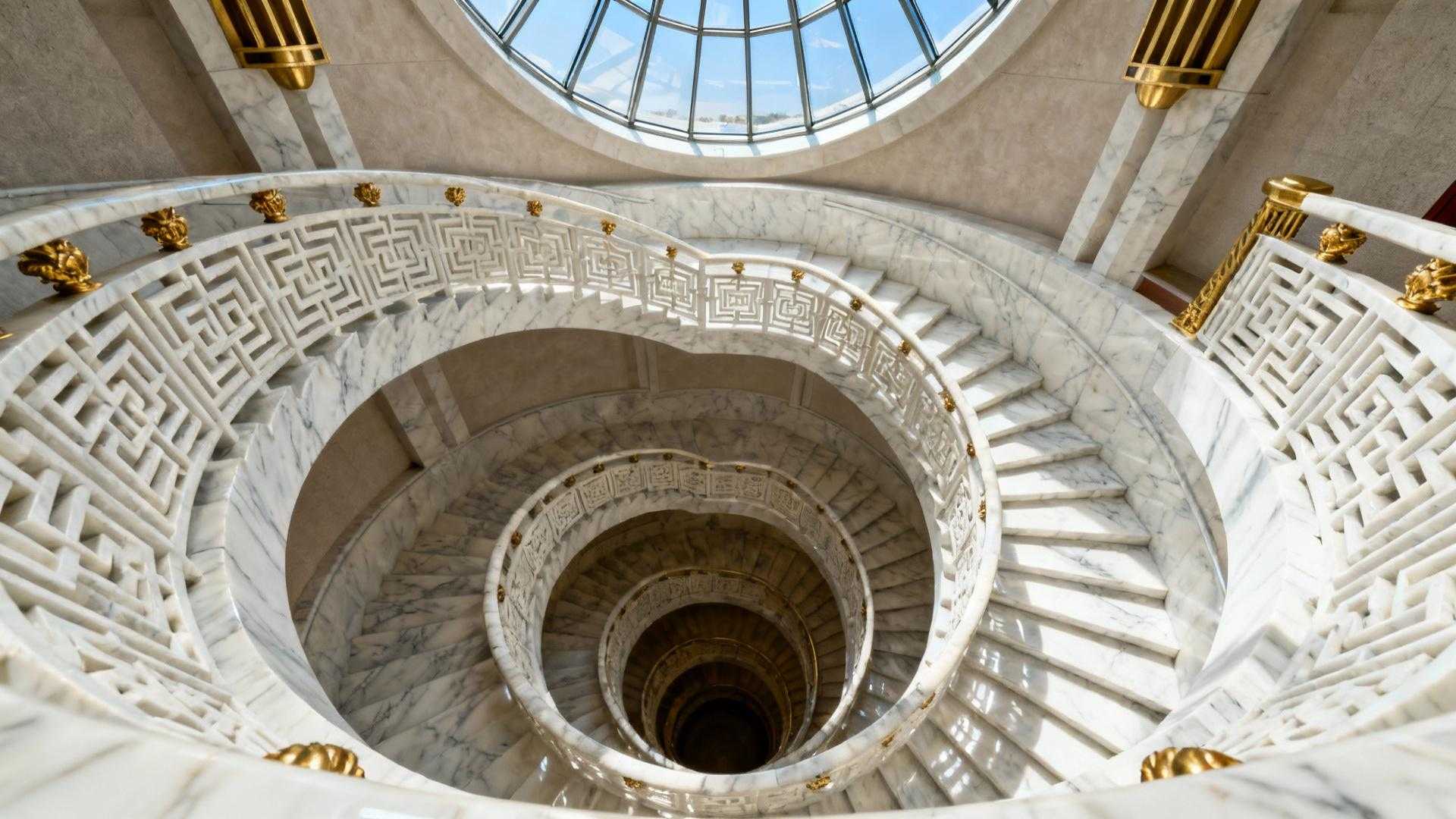Downtown Chicago’s financial district hides an architectural secret that most visitors racing between Willis Tower and Millennium Park never discover. Inside a 12-story building at 209 South LaSalle Street, Frank Lloyd Wright’s 1905 redesign created the only surviving downtown Loop project by America’s most celebrated architect. The Rookery Building’s spiral staircase and luminous light court produce an optical illusion that stops architectural photographers mid-step, their cameras struggling to capture how Wright’s white Carrara marble seems to glow from within.
This isn’t another tourist observation deck charging $30 for elevator access. Wright transformed Daniel Burnham and John Root’s 1888 iron-frame marvel into a gleaming Persian-inspired sanctuary where golden geometric patterns dance across marble surfaces under 5,000 glass panes. While crowds queue for generic skyscraper views, this medieval town sits on a salt mountain that grows every year proves architectural treasures hide inside functional buildings rather than static museums.
The Rookery represents Chicago’s triple-crown architectural legacy—three legendary designers collaborating across time to create something no other Loop building can claim.
Wright’s exclusive downtown masterpiece that transformed commercial design
The only surviving Loop project by Frank Lloyd Wright
Among Chicago’s 200+ downtown skyscrapers, the Rookery stands alone as Wright’s sole commercial contribution to the Loop’s skyline. While his Prairie School homes scattered across Oak Park suburbs, his 1905 light court renovation marks his only intervention in the city’s financial heart. Wright maintained offices here from 1898-1899, absorbing Root’s structural innovations before revolutionizing the interior with white marble incised with Persian-style arabesques.
Three architectural giants converging in one building
Burnham and Root engineered the 1888 skeleton that became one of the world’s tallest buildings at eleven stories. Their revolutionary hung masonry on steel frame pioneered techniques still used today. When building manager Edward C. Waller commissioned Wright’s renovation seventeen years later, the architect stripped Root’s ornamental ironwork and introduced Carrara marble with gilded Persian tracery—possibly referencing Burnham’s 1893 White City that still haunted Chicago’s imagination.
The spiral staircase creating architecture’s most photographed optical illusion
How Wright’s marble manipulation tricks your perception
The curving double staircase winds upward from the second-floor lobby, its white marble treads seeming to float against ornamental iron railings Wright personally designed. Decorative urns anchor the composition at ground level, but Wright’s genius lies in the marble’s reflective properties—natural light filtering through the glass ceiling above creates the illusion that stairs ascend into infinite brightness rather than the building’s 12th floor.
The oriel staircase photographers obsess over
On the building’s western side, an oriel staircase spirals down from the 12th floor through the central atrium, connecting with the light court at mezzanine level. Wright’s golden geometric patterns on white marble create rhythmic shadows that shift throughout the day, producing different optical effects as Chicago’s autumn sun tracks across Lake Michigan. Architectural tour guides call this “nature’s collaboration with Wright”—October’s clear skies provide the perfect illumination that photographers chase.
Inside access that requires insider knowledge to experience
Frank Lloyd Wright Trust’s protected tour operations
The Rookery functions as a working office building where 24,500 square feet per floor surround the open-air lightwell. The Frank Lloyd Wright Trust operates guided tours Monday through Friday from 10 AM to 1 PM for $13-20—half the cost of Willis Tower’s Skydeck. Just as the only British battlefield where 1,500 Highland clans’ sacred graves still demand respectful silence balances access with preservation, the Rookery limits daily visitors to protect Wright’s delicate interiors.
LEED Gold certification protecting Wright’s vision
The building achieved LEED Gold certification while maintaining its 1888 character—proving modern sustainability enhances rather than conflicts with historic preservation. Building management restricts access to preserve marble surfaces showing 120 years of patina, balancing public appreciation with conservation ethics that honor Wright’s transformative redesign.
Why October offers the ultimate light court experience
Perfect autumn illumination through 5,000 glass panes
Chicago’s 63°F October average provides comfortable walking weather between downtown architectural landmarks, while clear fall skies create optimal conditions for experiencing Wright’s light manipulation. The central skylight’s 5,000 glass panes filter autumn sun differently than summer’s harsh glare, producing softer shadows that accentuate the Persian geometric patterns.
Architecture tours peaking before holiday crowds arrive
Frank Lloyd Wright Trust guides offer their most detailed tours during October’s shoulder season, when fewer visitors allow longer discussions of Wright’s material choices. Similar to how this tiny 27-foot Utah arch has the Southwest’s most perfect sunrise frame demonstrates intimate scale creating powerful visual effects, the Rookery’s 181-foot height produces architectural intimacy impossible in modern glass towers.
Essential information for visiting Wright’s hidden Loop masterpiece
What makes the Rookery’s spiral staircase create an optical illusion?
Wright’s white Carrara marble reflects natural light from the 5,000-pane skylight above, creating the perception that stairs ascend into brightness rather than ending at the 12th floor. Golden Persian geometric patterns cast rhythmic shadows that shift throughout the day, producing different visual effects as sunlight angles change.
How do I access the light court inside this working office building?
The Frank Lloyd Wright Trust operates guided tours Monday-Friday from 10 AM-1 PM for $13-20. Tours last approximately 30 minutes and require advance booking during October’s peak architectural tour season. The building is located at 209 South LaSalle Street in Chicago’s Loop.
Why is this Wright’s only downtown Chicago project?
Wright maintained offices in the Rookery from 1898-1899 but focused his Chicago-area work on suburban Prairie School homes. His 1905 light court commission represented his sole commercial intervention in the Loop, making the building unique among downtown’s 200+ skyscrapers.
